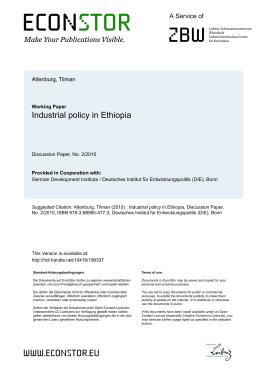Industrial pollicy in Ethiopia
Industrial pollicy in Ethiopia
Productivity growth is a precondition for increasing people’s living standards and maintaining competitiveness in the globalised economy. Low total factor productivity is the key reason for persistent poverty in developing countries. The productivity gap separating poor and rich countries has never been as deep as it is today. Poor countries in particular thus need to emphasise productivity growth to alleviate poverty. The challenge is not only to develop more productive ways of doing business in already established activities but also to accelerate the structural transformation from low-productivity activities in agriculture, petty trade and skill-extensive services to new activities that are knowledge-intensive and exploit the advantages of inter-firm specialisation.
Undoubtedly the main driver of structural change is the private sector. Still, governments have an important role to play in setting policy frameworks that allow for competition and encourage innovation and technological change as well as in correcting market failures. It may be important to encourage new activities that do not emerge spontaneously, e.g. because several interrelated investments need to be made simultaneously that exceed the possibilities of individual entrepreneurs, or to support activities that while unlikely to pay off right away for an individual investor, are still likely to produce manifold linkages and spillovers in the future. Governments may in this way accelerate structural change towards more competitive and higher value activities. This is what industrial policy is about.
While the theoretical case for industrial policy is not in doubt, there is no consensus about the right degree of intervention. The controversy is mainly about selective interventions that favour some sectors over others and thus interfere with the price mechanism, the main signalling device of market economies. Critics argue that governments are usually not very good at identifying coordination failures or anticipating future knowledge spillovers, and their decisions may well end up reducing allocative efficiency and creating perverse incentives for investors and bureaucrats alike.

